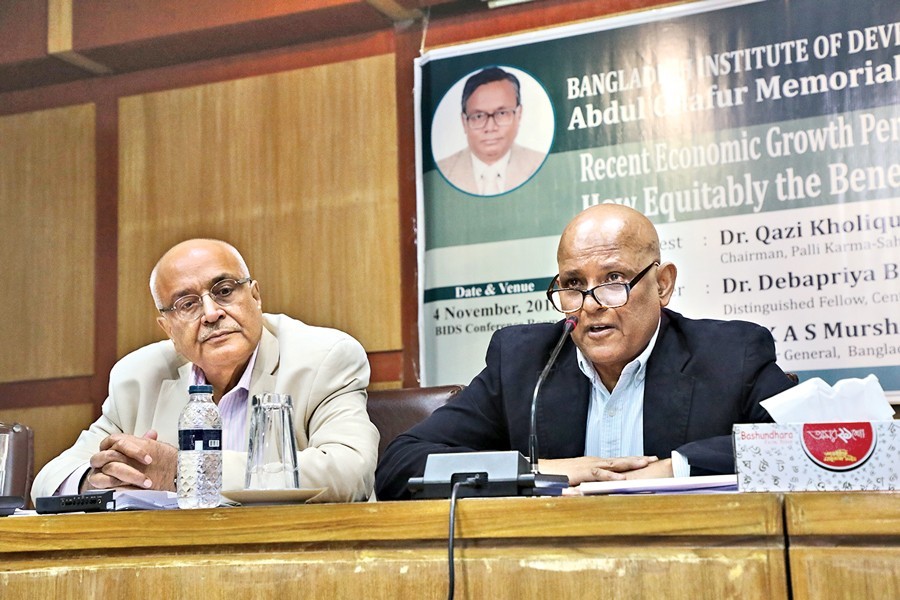Bangladesh economy has become more 'unequal' during the recent decade, particularly between 2010 and 2016, despite the country's ongoing growth, opined economist Dr Debapriya Bhattacharya.
Asset inequality is increasing at a faster pace than income inequality, and income inequality is increasing at a faster pace than consumption inequality, cautioned the Distinguished Fellow of Centre for Policy Dialogue (CPD), the country's leading think-tank.
He said these while delivering a lecture at Bangladesh Institute of Development Studies (BIDS) in the capital on Sunday.
"The uncomfortable truth of the recent development experience of our country is very simple. The benefits of our recent economic growth have been very unevenly distributed."
"In broad terms it has favoured the richest section of the rural population as well as the richer section of the urban population."
"The trends of growing inequality have been largely driven by higher concentration of income in the 10 percent of the population and greater concentration of assets in the top five percent of the same," Dr Bhattacharya observed.
To support his argument, the economist pointed at the alarming trend of income concentration in the country.
"The poorest five percent population of Bangladesh lost out two-third of their share in between 2010 and 2016, and now commands only a miniscule 0.23 percent of the total income."
"The top 10 percent, on the other hand, together with the top five percent of households, enhanced their share of income between 2010 and 2016," he added.
Dr. Bhattacharrya, in his speech, also highlighted the growing asset concentration in the country.
"At a disaggregate level, the bottom five percent households demonstrate loss in asset share, whereas the top five percent show noticeable rise in the same."
"Between the rural and the urban areas, while the rural poorest of the poor more or less could hold on to their low asset base, asset distribution in the urban areas became exceptionally skewed," he noted.
The CPD Distinguished Fellow also focused on the declining share of manufacturing sector in the job market despite its increased share in Gross Domestic Product (GDP).
"Manufacturing sector is demonstrating a rather stagnating, if not declining, employment situation. While in 2013, the sector hosted 9.5 million jobs, the figure dropped to 8.8 million in 2016-17."
"Its share in total employment also experienced a decline from 16.4 percent in 2013 to 14.5 percent in 2016-17," he added.
Dr Bhattacharya also noted that unemployment situation among the country's youth section projects a perverse scenario.
"In 2016-17, about 10.6 percent of the youth labour force was unemployed, while the figure was 7.4 percent in 2010."
When it comes to wage, the economist noted that the annual change in general wage rate followed an upward-moving, fluctuating trend till mid-2000.
"However, since the introduction of new base year, the trend has flattened out between 2011-12 and 2017-18."
He also noted that the growth in terms of education and health facilities has favoured the richer section more than the poor people.
"School enrolment of children was higher among the non-poor households (94.3 percent in 2016), compared to the poor households (89.9 percent in 2016)."
The CPD Distinguished Fellow also pointed out that the fruits of economic growth are not only being unevenly distributed among different socio-economic groups, but also across different parts of Bangladesh.
"For example, both general poverty rate and extreme poverty rate are systematically lower in Dhaka, Sylhet and Chittagong in comparison to the same in Barisal, Khulna, Mymensingh, Rajshahi and Rangpur."
Dr Bhattacharya also lamented the share market debacle of 2010-11, ongoing upward trend in non-performing loans (NPLs), and illicit outflow of money.
"It is maintained that the money siphoned off the capital market only during the bubble-burst of 2010-11 amounted to the tune of US$ 2,750 million."
"The total amount of NPLs reached a staggering $10,764 million, which is about 4.0 percent of GDP. Another 4.0 percent or more is illicitly flowing out of the country annually."
"If all these resources could have been invested in the country in a proper way, we would have a radically different gainful employment and inequality situation," he concluded.
Later, the speakers of the programme identified poor governance as one of the reasons behind the high income inequality.
They were also critical of high wastage and cost overrun in the public sector.
"Construction of one kilometre road costs five to 10 times more in Bangladesh than the cost in India. Inequality could have been lesser with lesser wastage," said BIDS Professorial Fellow Dr Asaduzzaman.
"Social innovations that could help to reduce the inequality are not taking place in Bangladesh since 1990s," said BIDS Director General K A S Murshid.
Noting that the emergence of high growth and high wage sector along with economic growth is crucial for reducing inequality, BIDS Research Director Binayak Sen said, "It is important to identify the structural barriers that are not leading to high growth and high wage sector."
Distinguished Fellow of CPD Professor Mustafizur Rahman said it is important to analyse the fiscal policies that are leading to such inequality.
Research Director of BIDS Dr Kazi Ali Toufique said the way the country is investing in education and health is itself an engine for inequality.
"This is a process of creative destruction. With growth, some negative things are supposed to happen," opined former Finance Secretary Dr Mohammad Tarek.


